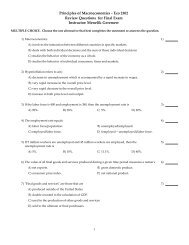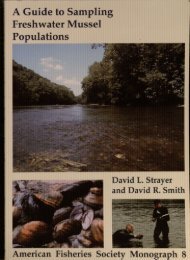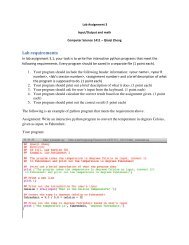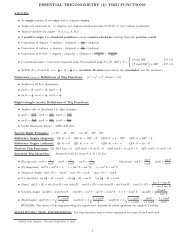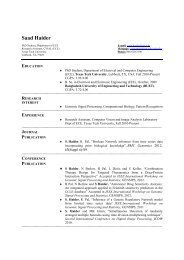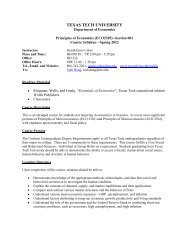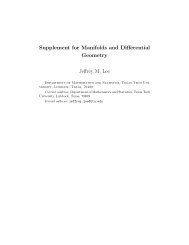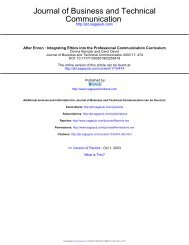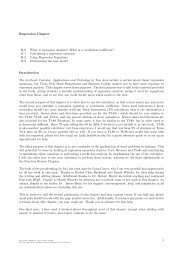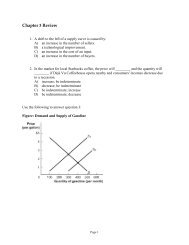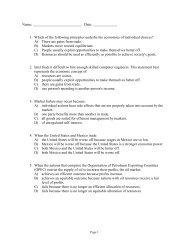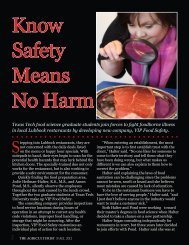Download - MyWeb - Texas Tech University
Download - MyWeb - Texas Tech University
Download - MyWeb - Texas Tech University
You also want an ePaper? Increase the reach of your titles
YUMPU automatically turns print PDFs into web optimized ePapers that Google loves.
The 2012 Season of the Chan Chich Archaeological Project<br />
of carvings, but none were recognized. The<br />
dimensions of Fragment 1 are: 40 cm wide on<br />
the western edge, 80 cm wide on the eastern<br />
edge, 1.1 m in length, and 50–55 cm thick.<br />
Stela Fragment 2 (Lot KU-1-A-3) was<br />
standing in an upright position, perpendicular<br />
to Structure 3, and is considered to be the top<br />
half of the stela. The north face of Fragment<br />
2 matches the top surface of Fragment 1. It<br />
was once carved, but no details are preserved.<br />
We have concluded that Stela Fragment 2<br />
was reset into its current position, explaining<br />
its orientation perpendicular to the building,<br />
instead of the more common parallel placement<br />
to its associated structure. Dimensions of stela<br />
Fragment 2 are 75 cm wide, 85 cm in length,<br />
and 50 cm thick.<br />
Once both of the fragments were removed<br />
from Subop KU-1-A, they were positioned<br />
next to each other confirming that they once fit<br />
together, with only one face of the monument<br />
apparently carved. Together the two fragments<br />
would have measured 1.95 m tall, 75–80 cm<br />
wide, and 50–55 cm thick. If our interpretation<br />
is correct, when Stela 1 was in an upright<br />
position the carvings would have been visible<br />
from the plaza looking east toward Structure 3.<br />
During the excavations of the two suboperations,<br />
the humus layer (Lot KU-1-A-1 and Lot KU-<br />
1-E-1) consisted of dark (10YR3/2, very dark<br />
grayish brown) organic soil with lots of rootlets<br />
and several medium roots. Lot KU-1-A-1 was<br />
arbitrarily terminated upon reaching a change<br />
in soil color to a lighter matrix (10YR5/2,<br />
grayish brown). Also, because of the location<br />
around Stela 1, all of the topsoil was screened to<br />
maximize collection of artifacts. In the topsoil<br />
surrounding the base of Stela 1 (Lots KU-<br />
1-A-1 and -4) multiple fragments of Chen Mul<br />
modeled ceramics with incising and molded<br />
appliqué were collected. Smith (1971:Chart 1)<br />
places Chen Mul modeled in the Tases ceramic<br />
phase in the Yucatan, which he dates to the Late<br />
Postclassic period (A.D. 1300–1450). Their<br />
use as incensarios is assumed because of the<br />
presence of burned concave surfaces and their<br />
style. Among the collected ceramic assemblage<br />
were two complete arm and hand fragments<br />
decorated with molded appliqué bracelets,<br />
two molded and incised figurine faces—one<br />
complete and one broken in two pieces—and<br />
several other molded fragments with applique<br />
(Figure 5.4).<br />
Lot KU-1-A-4 below topsoil consisted of a very<br />
dark grayish brown matrix (10YR4/2) mixed<br />
with small limestone cobbles. This lot varied<br />
in depths from the north meter where a mixture<br />
of larger limestone blocks was uncovered (Lot<br />
KU-1-A-5) and the southern meter where<br />
a compact cobble and marl mixture was<br />
uncovered (Lot KU-1-A-6). The thickness of<br />
Lot KU-1-A-4 averaged approximately 5 cm in<br />
the north meter and 15 cm in the south meter.<br />
Additionally, in the northern half of Subop KU-<br />
1-A, a single ammunition cap from a center<br />
fire shotgun shell was collected, indication of<br />
continued visitation to the site, possibly from<br />
the historic chicle camp nearby (see Houk, this<br />
volume).<br />
Below the northern section of Lot KU-1-A-4<br />
was Lot KU-1-A-5, which consisted of a 20-<br />
cm thick layer of limestone cobble and cut<br />
limestone blocks that have been interpreted as<br />
construction fill for the plaza surface, which<br />
has completely eroded. Lot KU-1-A-5 was<br />
terminated upon reaching the same compact<br />
mixture of small cobbles and marl matrix in<br />
the southern half of the unit. Lot KU-1-A-6<br />
was a mixture of clay with small marl matrix,<br />
and medium sized cobbles containing a limited<br />
amount of artifacts. KU-1-A-6 averaged depths<br />
of 10–15 cm; difficulty excavating the clay<br />
matrix resulted in terminating Subop KU-<br />
1-A to shift focus onto Subop KU-1-E which<br />
allowed excavations to reach a culturally sterile<br />
level (discussed below).<br />
52



